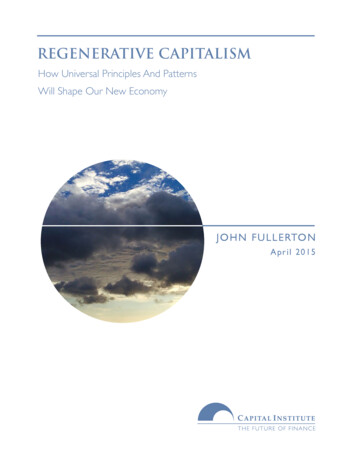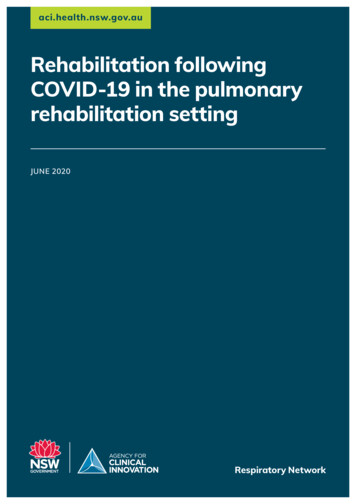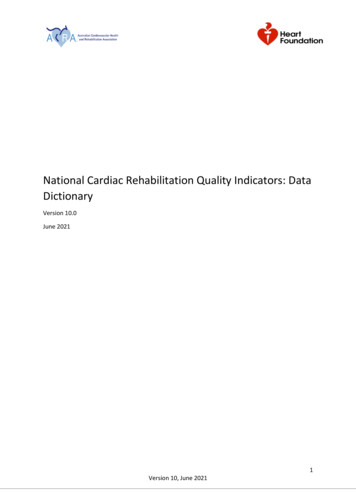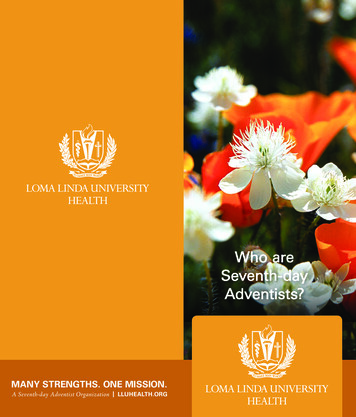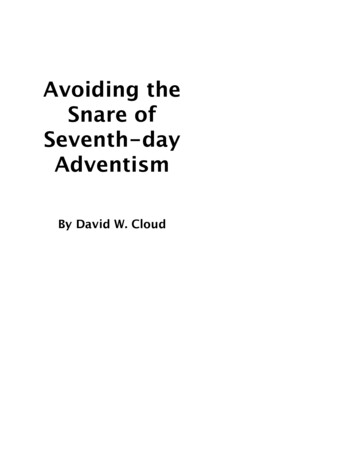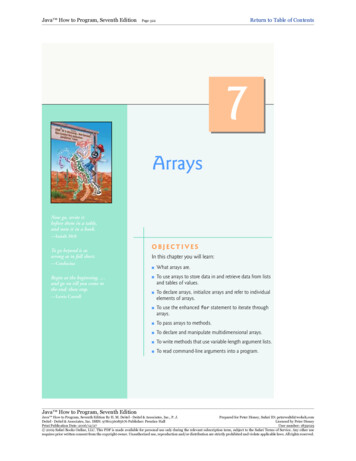
Transcription
Seventh AnnualInternational Regenerative RehabilitationSymposiumWhere applied biophysics meetstissue engineering and cellular therapiesOctober 11-13, 2018O C T O B E R 1 1 - 1 3 , 2 0 1 8 S E AT T L E , WA S H I N G T O N1
WelcomeIt is our great pleasure to welcome you to Seattle and the SeventhAnnual International Symposium on Regenerative Rehabilitation.It has been another wonderful year in the field of regenerative rehabilitation, ascollaborations and research in the field grew at an exponential pace. Within the lastyear, our international partnerships have grown to 16 participating institutions, with theUniformed Services University of the Health Sciences, AO Research InstituteDavos, the Kessler Foundation, and Fondazione Don Carlo Gnocchi joining theUniversity of Pittsburgh; Stanford University; the University of California, SanFrancisco; the Mayo Clinic; Emory University; the University of Virginia; KyotoUniversity; the University Hospital of Pisa; Indiana University; Oregon Health &Science University; the University of Washington; and Wayne State University.We are thrilled to be hosted by the University of Washington at this year’s event.Over the next two and a half days, you can expect to learn about cutting-edge andtranslational research in the domain of regenerative rehabilitation. We have a greatagenda planned, covering multiple applicable areas of regenerative rehabilitation. Manydistinguished clinicians and scientists and faculty members will be taking part in thissymposium. Abstracts presented will be in the form of keynote, plenary, and postersessions and will include rigorous and thoughtful scientific material. The presenterswere carefully recommended and selected by the Scientific Program Committee andwere approved by the course directors. These efforts have worked to ensure that themeeting will be a memorable scientific event.We thank you for participating in this year’s meeting and for bringing your expertiseand thoughtful perspective to our gathering. We hope that you will enjoy the symposiumand that your interactions with various colleagues from around the world will stimulate acreative exchange of ideas. Please enjoy your visit to Seattle, an exciting urban citysurrounded by unmatched natural beauty.Best wishes,Fabrisia Ambrosio, PhD, MPTMichael Boninger, MDAnthony Delitto, PhD, PT, FAPTAThomas Rando, MD, PhDWilliam R. Wagner, PhDO C T O B E R 1 1 - 1 3 , 2 0 1 8 S E AT T L E , WA S H I N G T O N1
Course DirectorsFabrisia Ambrosio, PhD, MPTAssociate Professor, Department of Physical Medicine and RehabilitationUniversity of PittsburghDirector of Rehabilitation, UPMC InternationalMichael Boninger, MDProfessor and UPMC Endowed Vice Chair for Research,Department of Physical Medicine and RehabilitationUniversity of Pittsburgh School of MedicineAnthony Delitto, PhD, PT, FAPTADean, School of Health and Rehabilitation SciencesProfessor, Department of Physical TherapyUniversity of PittsburghThomas A. Rando, MD, PhDProfessor, Department of Neurology and Neurological SciencesStanford University School of MedicineDirector of Rehabilitation Research and Development andProgram Chief of Neurology, VAPalo Alto VA Health Care SystemWilliam R. Wagner, PhDDirector, McGowan Institute for Regenerative MedicineProfessor of Surgery, Chemical Engineering, and BioengineeringUniversity of PittsburghScientific Program Committee CochairsFabrisia Ambrosio, PhD, MPTAssociate Professor, Department of Physical Medicine and RehabilitationUniversity of PittsburghDirector of Rehabilitation, UPMC InternationalDavid Mack, PhDAssistant Professor, Department of Rehabilitation MedicineInstitute for Stem Cell and Regenerative MedicineUniversity of Washington2SE VENTH ANNUAL REGENER ATIVE REHABILITATION SYMPOSIUM
Symposium OrganizersUPMC Center for Continuing Education in the Health SciencesThe purpose of the Center for Continuing Education in the Health Sciences is toadvance the academic, clinical, and service missions of the University of Pittsburghschools of the health sciences and the University of Pittsburgh Medical Center (UPMC)through the continuing professional development of physicians, pharmacists, and otherhealth professionals and the translation of biomedical knowledge into clinical practice.ccehs.upmc.comMcGowan Institute for Regenerative MedicineThe McGowan Institute for Regenerative Medicine is a partnership between theUniversity of Pittsburgh and UPMC and serves as a base for scientists and clinicalfaculty working in tissue engineering and biomaterials, cellular therapies, and medicaldevices and artificial organs. McGowan’s mission is the development of innovativeclinical protocols and the commercial transfer of new technologies.mcgowan.pitt.eduUPMC Rehabilitation InstituteThe largest rehabilitation provider in Western Pennsylvania, the UPMC RehabilitationInstitute serves as the hub of a UPMC network of more than 70 rehabilitationfacilities that combine clinical care and research to help patients regainindependence and enhance their quality of life. The institute’s academic partnersinclude the Department of Physical Medicine and Rehabilitation in the Universityof Pittsburgh School of Medicine and the Pitt School of Health and RehabilitationSciences. These academic partners are national and international leaders inrehabilitation research and niversity of Pittsburgh Department of Physical Medicine andRehabilitationThe mission of Pitt’s Department of Physical Medicine and Rehabilitation is tomaximize the health, function, and well-being of the people and populations we serveby providing the highest quality rehabilitative medical care; conducting highly relevant,cutting-edge research; and training the next generation of clinicians and researchers.Our research portfolio includes: neural engineering and neural prosthetics; biologics asindicators of pain, injury and recovery; axon regeneration; biomarkers for brain injury;medical homes for spinal cord injury care; and motor learning using transcranialmagnetic stimulation.The department’s physicians are experts in the fields of traumatic brain injury,spinal cord injury, sports and musculoskeletal medicine, stroke, and many conditionsthat would benefit from rehabilitation care. We partner with patients to design andimplement personalized approaches that maximize participation, recovery, andwell-being.rehabmedicine.pitt.eduO C T O B E R 1 1 - 1 3 , 2 0 1 8 S E AT T L E , WA S H I N G T O N3
Symposium Organizers, continuedUniversity of Pittsburgh School of Health and Rehabilitation SciencesThrough academic research, technology design, and rigorous training, the Schoolof Health and Rehabilitation Sciences (SHRS) at the University of Pittsburgh educatesthe next generation of health professionals who will help others to reach their fullestpotential.SHRS is committed to providing the best learning experience and academicenvironment possible for our students. Instructional excellence is rigorously pursued.Class sizes are intimate, fostering intellectual exchange and discourse. Students arechallenged not just to achieve but to excel—and they do. Graduates of SHRS programsare some of the most sought-after professionals. They are authors, clinicians, andnoted researchers; speakers, and consultants. Above all, they are teachers who carepassionately about their field and about their students. They want their students tosucceed in the classroom and in their chosen professions. An SHRS education is morethan classroom lectures. It’s hands-on learning either in a clinical setting or in thecommunity. Through our strong relationships with the University of Pittsburgh MedicalCenter and other clinical partners, our students benefit from a wealth of experiencesrelated to their particular field and area of interest. Students train in schools, hospitals,skilled nursing facilities, ambulatory care sites, and home- and community-basedsettings.Undergraduate and graduate degrees, and certificates are offered in these areasof study: clinical dietetics and nutrition; communication science and disorders; speechlanguage pathology; audiology; emergency medicine; health information management;occupational therapy; physical therapy; physician assistant studies; prosthetics andorthotics; rehabilitation counseling; rehabilitation science (undergraduate); rehabilitationscience and technology; and sports medicine/athletic trainingshrs.pitt.eduRehabilitation Research and Development Program at the VA Palo AltoHealth Care System Center for Tissue Repair, Regeneration,and RestorationThomas Rando directs the Rehabilitation Research and Development (R&D) programat the Palo Alto VA. Within that program, the Center for Tissue Repair, Regeneration,and Restoration (CTR3) focuses primarily on the neuromuscular and musculoskeletalsystems and pursues research at the levels of stem cell biology, biomedicalengineering, and clinical/translational research.The VA Palo Alto Rehabilitation R&D Program reflects a long-standing commitmentby the U.S. Department of Veterans Affairs to advance the well-being of Americanveterans through support of a full spectrum of rehabilitation research, from concept toclinic.A firm scientific understanding of the underlying impairment and a multidisciplinaryteam creates a strong basis for developing new clinical treatments that reduce thedisability of veterans and improve the effectiveness of health care delivery by VAclinicians.rehab.research.va.gov4SE VENTH ANNUAL REGENER ATIVE REHABILITATION SYMPOSIUM
Symposium SponsorsInternational Consortium on Regenerative Rehabilitation (ICRR)The Alliance for Regenerative Rehabilitation Research and Training (AR3T)Eunice Kennedy Shriver National Institute of Child Health and Human Development (NICHD)National Institute of Neurological Disorders and Stroke (NINDS)National Institute of Arthritis and Musculoskeletal and Skin Diseases (NIAMS)National Institute of Biomedical Imaging and Bioengineering (NIBIB)UPMC Center for Rehabilitation ServicesSpecial Thanks to our Corporate Sponsor, Juvent HealthJuvent is the current leader of clinically proven, safe mechanotransduction for tissue regeneration, healing, and health. Juvent’smicro-impact technology has been published in the leading journals and today can help 50 million Americans to live longer,pain-free lives.Juvent’s mission is to help proven science become clinically available with safety, efficacy, and affordability to all. Juvent helps theworld's top researchers, clinicians, regulators, and providers work together to help to ensure that regenerative science becomes ng for this conference was made possible (in part) by 2 R13 HD 085724-04 from the Eunice KennedyShriver National Institute of Child Health and Human Development (NICHD).Research reported during this symposium was supported by the Eunice Kennedy Shriver National Institute of Child Healthand Human Development of the National Institutes of Health under award number R13HD085724. The content is solelythe responsibility of the authors and does not necessarily represent the official views of the National Institutes of Health.ExhibitorsWe gratefully acknowledge support from the following:Alliance for Regenerative Rehabilitation Research and Training (AR3T)ar3t.pitt.eduNIH National Medical Rehabilitation Research Resource (MR3) Networkncmrr.orgNational Rehabilitation Research Resource to Enhance Clinical Trials (REACT)react.centerEndorsed by:termis.orgO C T O B E R 1 1 - 1 3 , 2 0 1 8 S E AT T L E , WA S H I N G T O N5
CohostsUniversity of Washingtonwashington.eduThe University of Washington (UW) is one of the world’s preeminent public universities. Its impact on individuals, the region, andthe world is profound—whether launching young people into a boundless future or confronting the grand challenges of today throughundaunted research and scholarship. Ranked 13th in the world on the 2017 Academic Ranking of World Universities, UW educatesmore than 54,000 students annually. UW turns ideas into impact and transforms lives and the world.To learn more, visit washington.edu/news.So what defines UW students, faculty, and community members? Above all, it is a belief in possibility and unshakable optimism.It’s a connection to others near and far. It’s a hunger to tackle challenges and pursue progress.6SE VENTH ANNUAL REGENER ATIVE REHABILITATION SYMPOSIUM
University of Pittsburghpitt.eduFounded in 1787, the University of Pittsburgh is one of the oldest institutions of higher education in the United States. Pitt peoplehave defeated polio, unlocked the secrets of DNA, led the world in organ transplantation, and pioneered TV and heavier-than-airflight, among numerous other accomplishments.From research achievements to the quality of its academic programs, the University of Pittsburgh ranks among the bestinstitutions of higher education including being named the top public university in the Northeast by the Wall Street Journal.Faculty members have expanded knowledge in the humanities and sciences, earning such prestigious honors as the NationalMedal of Science, the MacArthur Foundation’s “genius” grant, the Lasker-DeBakey Clinical Medical Research Award, and election tothe National Academy of Sciences and the National Academy of Medicine.Pitt students have earned Rhodes, Goldwater, Marshall, and Truman Scholarships, among other highly competitive national andinternational scholarships. Alumni have pioneered MRI and TV, won Nobel and Pulitzer prizes, led corporations and universities,served in government and the military, conquered Hollywood and the New York Times bestsellers list, and won Super Bowls and NBAchampionships.O C T O B E R 1 1 - 1 3 , 2 0 1 8 S E AT T L E , WA S H I N G T O N7
Cohosts, continuedInternational Consortium for Regenerative Rehabilitationar3t.pitt.edu/icrrThe International Consortium for Regenerative Rehabilitation (ICRR) Leadership Council is a core of vested individuals andinstitutions who are interested in expanding the strategic footprint of the field of regenerative rehabilitation. Currently, 28researchers and clinicians representing 16 academic institutions from around the world are partnering to deliver upon a mission thatincludes educating and training scientists and clinicians across the domains of regenerative medicine and rehabilitation science. Thelong-term objective of the consortium is to catalyze interdisciplinary collaborations to create new strategies and technologies that willenhance functional recovery and, thus, the quality of life of patients.The leadership council plays a key role in shaping the future of the field by: framing the scientific content for the annual industry symposium; demonstrating leadership in the field and introducing emerging trends, therapies, and other information throughthe symposium, serving as spokespersons for the field as it emerges; providing valuable insight and guidance to young investigators, clinicians, therapists and others interested inpursuing regenerative rehabilitation as a career by having firsthand knowledge of potential funding, collaborations,and other opportunities to advance research and clinical activities; and building a new area of science that will have a positive impact on patient outcomes in the future.8SE VENTH ANNUAL REGENER ATIVE REHABILITATION SYMPOSIUM
Course Overview and ObjectivesOverviewAdvances in the field of regenerative medicine are accelerating at an unprecedented rate. Regrowing a lost limb, restoring functionto a diseased organ, and harnessing the body’s natural ability to heal itself are becoming part of our reality instead of distantpromises. Technologies such as cellular therapies, bioscaffolds, and artificial devices are now in use or are being tested in clinicaltrials throughout the country.How do we as clinicians and rehabilitation professionals work with the patient’s regenerative medicine team to maximize patientoutcomes and to help fully translate research? How do we as investigators in the field of regenerative medicine make the most ofthese revolutionary results?Few opportunities are available to bring together scientists and clinicians working in the two currently disparate fields ofrehabilitation science and regenerative medicine. However, rehabilitation science and regenerative medicine have to work togetherclosely in order to achieve a successful outcome for the patient. This situation created the need for open, cross-disciplinary work andcollaborative communication. This symposium provides the opportunity for researchers and clinicians from around the world to gatherand learn about the latest developments, share ideas and concepts, and create sustainable collaborations.ObjectivesDuring this course, participants will: interact with cutting-edge researchers; learn of the status of translating scientific discoveries into clinical practice; network with colleagues and potential collaborators; raise questions, debate implications, plan follow-up studies, and discuss results; share the status of their own research and clinical observations; and meet with presenters to learn about their thinking and future research directions.Continuing Education CreditContinuing Medical Education credits from AMA PRA Category 1 are currently pending approval. Please send questions torehabmtg@pitt.edu for updates.Note: Physicians should claim only the credit commensurate with the extent of their participationin the activity.Physical Therapy ProfessionalsThe symposium received approval through the Federation of State Boards of Physical Therapy’s ProCert program to offer 11continuing competency units (CCUs) for the 33 states and Puerto Rico that accept ProCert accredited hours toward license renewals.For more details on the ProCert program and a list of the 33 states, please visit: ation.*CCUs are a unit of relative value of an activity based on its evaluation against a comprehensive set of standards. The CCUdetermination is a valuation reflecting many factors including, but not limited to, duration of the activity. No conclusion should bedrawn that ProCert’s CCUs correlate to time or duration.Participation by all individuals is encouraged. Advance notification of any special needs will help us to provide better service.Please notify us of your needs at least two weeks in advance of the program by calling 1 412-624-5293.O C T O B E R 1 1 - 1 3 , 2 0 1 8 S E AT T L E , WA S H I N G T O N9
AgendaThursday, October 11, 2018Open SymposiumNoon–6 p.m.Registration Open Location: Lake Washington Foyer5:30–5:45 p.m.Welcome Location: Lake Washington Ballrooms5:45–7 p.m.Opening Plenary Session: Cardiovascular Disease Applications5:30–5:45 p.m.David Mack, PhDAssociate Professor, Rehabilitation MedicineUniversity of WashingtonModerator: David Mack, PhDAssociate Professor, Rehabilitation MedicineUniversity of Washington5:45–6 p.m.“Regenerating the Heart”Keynote Speaker: Charles Murry, MD, PhDProfessor and Director, Center for Cardiovascular BiologyUniversity of Washington6:20–6:40 p.m.“Muscle Function Recovery following Ischemic Injury”Laura Suggs, PhDAssociate Professor, Biomedical EngineeringUniversity of Texas at Austin6:40–7 p.m.“Functional Assessment of Cardiomyocytes Derived from Human Pluripotent Stem Cells”Nate Sniadecki, PhDAssociate Professor, Mechanical EngineeringUniversity of WashingtonAjourn for the Day7–9 p.m.10Welcome Reception Location: Lake Washington Ballroom Foyer and Great RoomSE VENTH ANNUAL REGENER ATIVE REHABILITATION SYMPOSIUM
Friday, October 12, 20187:30 a.m.–6 p.m.Registration Open Location: Lake Washington Foyer7:30–8:30 a.m.Continental Breakfast Location: Marina RoomOpen Day Two8:45–9:05 a.m. Welcome Location: Lake Washington Ballrooms8:45–8:55 a.m.Fabrisia Ambrosio, PhD, MPTAssociate Professor, Physical Medicine and RehabilitationUniversity of Pittsburgh8:55–9:05 a.m.Peter C. Esselman, MDChair, Department of Rehabilitation MedicineUniversity of Washington9:05–9:50 a.m.“Robotics for Regenerative Rehabilitation after Neurologic Injury”Regenerative Rehabilitation TechnologiesKeynote Speaker: David J. Reinkensmeyer, PhDProfessor, Mechanical and Aerospace Engineering and Biomedical EngineeringUniversity of California, Irvine9:50 – 10:10 a.m.Morning Break10:10–11:35 a.m.Applied Mechanobiology, Part One Location: Lake Washington Ballrooms10:10-10:35 a.m.“Physiologic, Genetic, and Epigenetic Principles: Optimizing Regeneration Capacity after SCI”Richard Shields, PhD, PTChair, Physical Therapy and Rehabilitation ScienceUniversity of IowaModerator: Nick Willett, PhDAssistant Professor, OrthopaedicsEmory University10:35–11 a.m.“Engineering the Optimal Environment for Neural Regeneration”Paul George, MD, PhDAssistant Professor, NeurologyStanford University Medical Center11–11:25 a.m.“Muscle Protection for Muscular Dystrophies: A Common Sense Rehabilitation Strategy toOptimize Patient Readiness for Gene and Regenerative Therapies”Joseph Roche, BPT, Dip. Rehab. PT, PhDAssistant Professor, Physical TherapyWayne State UniversityO C T O B E R 1 1 - 1 3 , 2 0 1 8 S E AT T L E , WA S H I N G T O N11
Agenda, continuedFriday, October 12, 201811:25–11:35 a.m.“Therapeutic Effects of Combined Cell Transplantation and Rehabilitation in Rats with Brain Injury”Takafumi Shimogawa, MDKyoto University11:35–11:45 a.m.Rapid Fire Presentations Selected from Poster AbstractsCharles Latchoumane PhD, MS, University of GeorgiaHikaru Mamiya, University of PittsburghAkira Ito, PhD, Kyoto UniversityBo Ri Seo, PhD, Harvard UniversityAjourn for Lunch and Poster Session11:45 a.m.–noonGroup Photo Location: TBDNoon–12:45 p.m.Lunch Location: Marina Room12:45–2:15 p.m.Poster Session and Refreshments Location: Great RoomSponsored by the International Consortium on Regenerative RehabilitationReconvene—Start Afternoon Sessions2:15–3:15 p.m.Applied Mechanobiology, Part Two Location: Lake Washington BallroomsModerator: Joseph Roche, BPT, Dip. Rehab. PT, PhDWayne State University2:15–2:40 p.m.“Using Mechanobiology to Accelerate Bone Healing”Christopher H. Evans, PhDProfessor, Orthopedics and Physical Medicine and RehabilitationMayo Clinic2:40–3:05 p.m.“Biomechanical Regulation of Musculoskeletal Cell Fate: From Strain to Secretome”Martin Stoddart, PhDPrincipal ScientistAO Research Institute Davos3:05–3:15 p.m.“Promoting Bone Regeneration by Optimization of Rehabilitation Protocols”Jan BarcikAO Research Institute Davos3:15–4:40 p.m.Regenerative Rehabilitation for Military Medicine Location: Lake WashingtonBallroomsModerator: George J. Christ, PhDProfessor, Biomedical Engineering and Orthopaedic SurgeryUniversity of Virginia3:15–3:25 p.m.“Clinical Development of Regenerative Rehabilitation Products for Military Applications”Colonel David L. Saunders, MD, MPHMedical Director, Combat Trauma and Acute RehabilitationU.S. Army Medical Materiel Development Activity12SE VENTH ANNUAL REGENER ATIVE REHABILITATION SYMPOSIUM
Friday, October 12, 20183:25–3:50 p.m.3:50–4:05 p.m.4:05–4:30 p.m.4:30–4:40 p.m.“Regenerative Rehabilitation in the Challenges and Clinical Research Gaps”Nelson Hager, MD, MSVice Chair, Department of Physical Medicine and RehabilitationUniformed Services University of the Health SciencesAfternoon Break“Basic Science Initiatives in Regenerative Rehabilitation in the Military”Shailly Jariwala, PhDSenior Biomedical EngineerUniformed Services University“Is the Metabolic Plasticity of the Muscle Remaining after Volumetric Muscle Loss Injurya Limitation to Rehabilitation Efficacy?”Sarah M. Greising, PhDUniversity of Minnesota4:40–5:05 p.m.Break: Refreshments in Great Room5:05–5:55 p.m.Closing the Gap: Funding and Education Location: Lake Washington BallroomsModerator: TBA5:05–5:15 p.m.“Regenerative Rehabilitation: The Promise and the Challenge”Lloyd Rose, PhDClinical and Rehabilitative Medicine Research ProgramU.S. Army Medical Research and Materiel Command5:15–5:25 p.m.“Training Tomorrow’s Leaders”Trevor Dyson-Hudson, MDDirector, Spinal Cord Injury Research and Outcomes and Assessment ResearchKessler Foundation5:25–5:35 p.m.“Programs to Support Regenerative Rehabilitation Research”Alison Cernich, PhDDirector, National Center for Medical Rehabilitation ResearchEunice Kennedy Shriver National Institute of Child Health and Human Development5:35–5:55 p.m.Panel Discussion5:55–6 p.m.Conclusion of Day TwoClosing Remarks for the DayDinner on Your Own8–10:30 p.m.Student Social Location: Woodmark Beach CaféO C T O B E R 1 1 - 1 3 , 2 0 1 8 S E AT T L E , WA S H I N G T O N13
Agenda, continuedSaturday, October 13, 20187 a.m.–noonRegistration Open Location: Marina Room Foyer7–7:45 a.m.Clinical Special Interest Group Breakfast Location: Bayshore Room7–8 a.m.Opening of Day 38–8:05 a.m.Continental Breakfast Location: Marina Room8:05–9:55 a.m.Translating the Science: Clinical Trials Location: Marina RoomFabrisia Ambrosio, PhD, MPTAssociate Professor, Physical Medicine and RehabilitationUniversity of PittsburghModerator: Marzia Bedoni, PhDResearch Coordinator, Nanomedicine and Clinical Biophotonics Area, BiomedicalTechnology DepartmentFondazione Don Carlo Gnocchi8:05–8:30 a.m.“Tribulations in Translation from the Preclinical Side of Stroke Neurorehabilitation”Theresa A. Jones, PhDProfessor, Psychology and Neuroscience InstituteUniversity of Texas at Austin8:30–8:55 a.m.“Engineered Neuroplasticity for Spinal Cord Rehabilitation”Chet Moritz, PhD, PTAssociate Professor, Rehabilitation MedicineUniversity of Washington8:55–9:20 a.m.“An Industry Perspective on Incorporating Rehabilitation Protocols in Clinical Researchfor Biologically Derives Scaffolds”Thomas Gilbert, PhDChief Science Officer, Research and Development and Clinical ResearchACell Inc.9:20–9:45 a.m.9:45–9:55 a.m.9:55–10:15 a.m.14Opening of Symposium“Emerging Approaches to Predict, Monitor, and Improve Physiological Resilience”Shawn Flanagan, PhD, MHAAssistant Professor, Sports Medicine and NutritionSchool of Health and Rehabilitation SciencesUniversity of Pittsburgh“An Affordable Device for Reach-to-Grasp Assistance in Patients with Upper Limb Impairment”Robert Matthew, PhD, M.EngUniversity of California at BerkeleyMorning BreakSE VENTH ANNUAL REGENER ATIVE REHABILITATION SYMPOSIUM
Saturday, October 13, 201810:15 a.m.–noonClinical Applications10:15–10:40 a.m.“Extracellular Vesicles Involved in Response to Rehabilitation Treatment of Neurological andCerebrovascular Diseases”Marzia Bedoni, PhDResearch Coordinator, Nanomedicine and Clinical Biophotonics Area, Biomedical TechnologyDepartmentFondazione Don Carlo Gnocchi10:40–11:05 a.m.“How Metabolic Coupling between Exercise and Diet Regulate Neural Repair”Isobel A. Scarisbrick, PhDAssociate Professor, Physical Medicine and Rehabilitation, and PhysiologyMayo Clinic11:05–11:30 a.m.“New Concepts in the Treatment of Orthopedic Conditions”Gerard Malanga, MDPhysiatrist and Head, Regenerative Medicine ProgramKessler Institute for Rehabilitation11:30 a.m.Discussion ModeratorPeter C. Esselman, MDChair, Department of Rehabilitation MedicineUniversity of WashingtonGroup Discussion: Better Communication/Engagement11:30 a.m.–noonNoon–12:15 p.m.Closing of SymposiumAnnouncement of Poster Contest WinnersFinal RemarksFabrisia Ambrosio, PhD, MPTAssociate Professor, Physical Medicine and RehabilitationUniversity of PittsburghPresentation of Awards Sponsored by the International Consortium ofRegenerative RehabilitationConclusion of SymposiumO C T O B E R 1 1 - 1 3 , 2 0 1 8 S E AT T L E , WA S H I N G T O N15
Agenda, continued12:30–2 p.m.Postsymposium WorkshopsTrack 1Preclinical Models for Regenerative RehabilitationLinda Noble-Haeusslein, PhDProfessor, Neurology and PsychologyUniversity of Texas at AustinTrack 2Clinical Study Design for Regenerative RehabilitationMarcas Bamman, PhD, FACSMProfessor, Cell Development and Integrative BiologyDirector, Center for Exercise MedicineUniversity of Alabama at BirminghamCourse Director BiosFabrisia Ambrosio, PhD, MPTFabrisia Ambrosio is the director of rehabilitation for UPMC International and an associate professor inthe Department of Physical Medicine and Rehabilitation at the University of Pittsburgh. She holds secondaryappointments in the Departments of Physical Therapy, Bioengineering, Orthopaedic Surgery, and Microbiologyand Molecular Genetics. In addition, she is a faculty member in the neurology residency program in theDepartment of Physical Therapy and a member of the McGowan Institute for Regenerative Medicine faculty.Ambrosio graduated with a Master of Science in physiology-endocrinology with a specialization in skeletalmuscle physiology from Laval University in Québec City, Québec, Canada. She also graduated with a Masterof Physical Therapy degree from the Medical College of Pennsylvania and Hahnemann University (now DrexelUniversity College of Medicine) in Philadelphia, Pa. In 2005, Ambrosio completed her PhD in rehabilitation science and technology atthe University of Pittsburgh.Ambrosio’s research has the long-term goal of developing regenerative rehabilitation approaches to improving skeletal musclehealing and functional recovery. Her laboratory uses murine and human models to investigate the underlying mechanisms by whichtargeted and specific mechanotransductive signals can be used to enhance donor and/or host stem cell functionality. Ambrosio’sresearch has been supported by the National Institutes of Health, the U.S. Department of Defense, the Foundation for PhysicalTherapy, Claude D. Pepper Older Americans Independence Center, and University of Pittsburgh Institute on Aging, among others.Ambrosio has published and recorded several educational modules on the topic of regenerative rehabilitation and has assumednational leadership roles in several work group efforts to promote the integration of regenerative medicine technologi
UPMC Rehabilitation Institute The largest rehabilitation provider in Western Pennsylvania, the UPMC Rehabilitation Institute serves as the hub of a UPMC network of more than 70 rehabilitation facilities that combine clinical care and research to help patients regain independence and enhance their quality of life. The institute's academic partners
